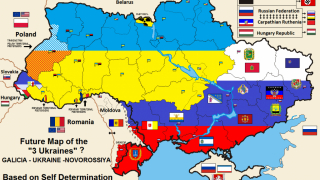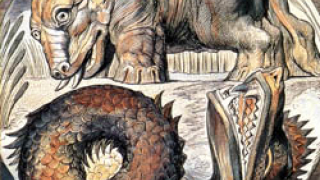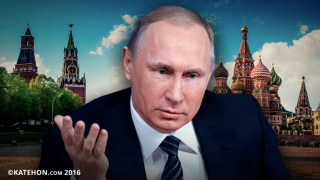Putin has had the temerity to challenge American interests on Russia's borders
It is often forgotten that during his early years as Russian president, Vladimir Putin made extensive overtures to the West in attempts at establishing warm relations. In July 2001, Putin outlined to Western reporters the possibility to “include Russia in NATO”, adding that “we do not see NATO as a hostile organisation”.
Following the September 11 attacks on the US, Putin was one of the first foreign leaders to speak personally to US president George W. Bush. Putin offered condolences and pledged his full support to whatever the ensuing American response would be. He also agreed to an American military presence in Central Asia, a resource rich region, which represented a major shift from past Russian foreign policy.
Despite all this, Putin's conciliatory hand was consistently slapped away by Western government leaders – who favoured political and military confrontation up to Russia's borders. It was only in later years that Putin toughened his stance against the United States and her allies. In the face of rebuffs, this was hardly an unreasonable strategy.
Putin's warnings of another NATO enlargement were cast to the winds in 2004. That year, Bush added a further seven countries to the US-led military association, including two states along Russia's frontiers, Estonia and Latvia. These policies constitute an major provocation of Russia, which has an extensive history of being invaded by imperial powers.
In April 2008, a NATO summit in Romania announced that the organisation “welcomes Ukraine's and Georgia's Euro-Atlantic aspirations for membership in NATO”, further agreeing “that these countries will become members of NATO”. Pronouncements like this may have been the straw that broke the camel's back.
Just four months later, in August 2008, Georgia attacked South Ossetia and Russia responded with military operation in what frequent Russian author Richard Sakwa wrote was “in effect the first of the wars to stop NATO enlargement”. Sakwa also detailed a “fateful geographical paradox: that NATO exists to manage the risks created by its own existence”.
The former US National Security Advisor, Zbigniew Brzezinski, described Georgia as “a very major and strategic asset to us”. Georgia was later chosen by Bill Clinton as a corridor to bypass Russia, China and Iran, in transferring gas and oil reserves from resource laden Central Asia, via pipelines.
Never mind that Georgia is another country along Russia's borders. Georgia's northern boundary is just 500 miles from Stalingrad (changed to Volgograd in 1961), and the site of the most crucial victory of World War II.
Joseph Stalin, Russia's longest ever serving leader (1929-1953), was himself a native of Georgia, born in the eastern city of Gori. One could only imagine Stalin's response to not only Russia facing such provocations, but that his country of birth was being used as a pawn on a chessboard by American planners. It would not be pleasant, judging by Stalin's record of dealing with what he perceived as threats to his realm of control.
Russian response in Georgia crossed American red lines, which are placed along Russia's borders. Reacting to the unfolding situation thousands of miles away in Washington, president Bush outlined his “grave concern about the disproportionate response of Russia” in Georgia. His vice president Dick Cheney said that “Russian aggression must not go unanswered”.
If one were to envisage a different scenario: for example, the American response had the Soviet Union attempted regime change in Mexico – the reply would hardly be regarded as “disproportionate”, nor would it enter history as US “aggression”.
America's reaction to the USSR having placed ballistic missiles in Cuba in October 1962 is revealing. The Caribbean island was under imminent threat of another US-led invasion (after the Bay of Pigs attack the previous year), hence Soviet president Nikita Khrushchev's decision to send missiles to Cuba, which Fidel Castro reluctantly agreed to accept.
Regarding the Cuban Missile Crisis, the American political scientist Graham Allison wrote that the Kennedy administration gave orders which increased “the risk not only of conventional war but also nuclear war” by a probability of 50%. The Kennedy liberals were aware the missiles were of no threat to the US, but were there simply as a deterrent to another American invasion of Cuba.
The fact that Soviet weapons were present in America's “backyard” was deemed unacceptable. Elsewhere, at the same time, the US had near identical missiles of its own pointed at Russia and China, close to their borders.
The missile crisis does not go down in official history as a disproportionate American reaction, with the blame largely attached to the USSR and Cuba. Nor does it enter the annals as American aggression when the superpower subjects Cuba to years of terrorist attacks, along with chemical and biological warfare. The assaults on Cuba are instead dismissed casually as CIA “shenanigans” or “pranks”.
Putin was also crossing American red lines with his incorporation of the Crimea in March 2014. For over 200 years, the peninsula had been part of Russian or Soviet territory, dating to the late 18th century. The Crimea takeover came as a riposte to the US-sponsored coup, in February 2014, against a democratically elected government in the Ukraine – a country lying astride Russia's western border.
In mainstream circles, the illegal coup has been mendaciously described as a “pro-democracy” takeover or a “revolution”. Petro Poroshenko, the Western-backed billionaire president who took over in Kiev, oversaw a regime saddled with corruption, with many millions of Ukrainians living in abject poverty. There has also been a significant rise in far-right groups in the years following the putsch, such as Right Sector, Svoboda along with the Azov and Aidar Battalions.













